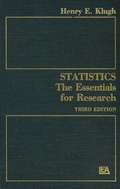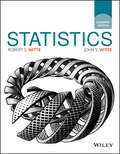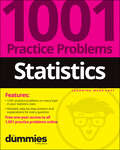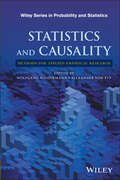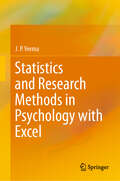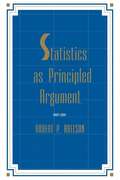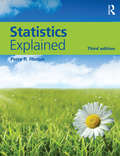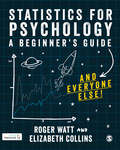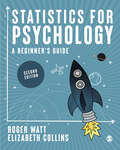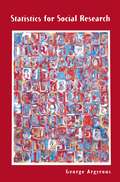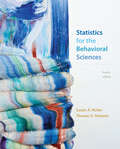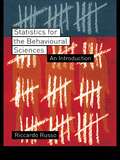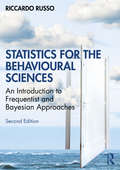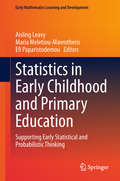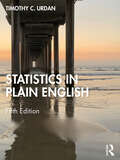- Table View
- List View
Statistics: The Essentials for Research
by Henry E. KlughPublished in 1986, Statistics is a valubale contribution to the field of Research Methods/Stats.
Statistics: The Essentials for Research
by Henry E. KlughPublished in 1986, Statistics is a valubale contribution to the field of Research Methods/Stats.
Statistics
by Robert S. Witte John S. WitteDrawing upon over 40 years of experience, the authors of Statistics, 11th Edition provide students with a clear and methodical approach to essential statistical procedures. The text clearly explains the basic concepts and procedures of descriptive and inferential statistical analysis. It features an emphasis on expressions involving sums of squares and degrees of freedom as well as a strong stress on the importance of variability. This accessible approach will help students tackle such perennially mystifying topics as the standard deviation, variance interpretation of the correlation coefficient, hypothesis tests, degrees of freedom, p-values, and estimates of effect size.
Statistics: 1001 Practice Problems For Dummies (+ Free Online Practice)
by The Experts at DummiesBecome more likely to succeed—gain stats mastery with Dummies Statistics: 1001 Practice Problems For Dummies gives you 1,001 opportunities to practice solving problems from all the major topics covered in Statistics classes—in the book and online! Get extra help with tricky subjects, solidify what you’ve already learned, and get in-depth walk-throughs for every problem with this useful book. These practice problems and detailed answer explanations will help you gain a valuable working knowledge of statistics, no matter what your skill level. Thanks to Dummies, you have a resource to help you put key stats concepts into practice. Work through practice problems on all Statistics topics covered in school classes Read through detailed explanations of the answers to build your understanding Access practice questions online to study anywhere, any time Improve your grade and up your study game with practice, practice, practiceThe material presented in Statistics: 1001 Practice Problems For Dummies is an excellent resource for students, as well as parents and tutors looking to help supplement Statistics instruction. Statistics: 1001 Practice Problems For Dummies (9781119883593) was previously published as 1,001 Statistics Practice Problems For Dummies (9781118776049). While this version features a new Dummies cover and design, the content is the same as the prior release and should not be considered a new or updated product.
Statistics: 1001 Practice Problems For Dummies (+ Free Online Practice)
by The Experts at DummiesBecome more likely to succeed—gain stats mastery with Dummies Statistics: 1001 Practice Problems For Dummies gives you 1,001 opportunities to practice solving problems from all the major topics covered in Statistics classes—in the book and online! Get extra help with tricky subjects, solidify what you’ve already learned, and get in-depth walk-throughs for every problem with this useful book. These practice problems and detailed answer explanations will help you gain a valuable working knowledge of statistics, no matter what your skill level. Thanks to Dummies, you have a resource to help you put key stats concepts into practice. Work through practice problems on all Statistics topics covered in school classes Read through detailed explanations of the answers to build your understanding Access practice questions online to study anywhere, any time Improve your grade and up your study game with practice, practice, practiceThe material presented in Statistics: 1001 Practice Problems For Dummies is an excellent resource for students, as well as parents and tutors looking to help supplement Statistics instruction. Statistics: 1001 Practice Problems For Dummies (9781119883593) was previously published as 1,001 Statistics Practice Problems For Dummies (9781118776049). While this version features a new Dummies cover and design, the content is the same as the prior release and should not be considered a new or updated product.
Statistics and Causality: Methods for Applied Empirical Research (Wiley Series in Probability and Statistics #2)
by Wolfgang Wiedermann Alexander Von EyeA one-of-a-kind guide to identifying and dealing with modern statistical developments in causality Written by a group of well-known experts, Statistics and Causality: Methods for Applied Empirical Research focuses on the most up-to-date developments in statistical methods in respect to causality. Illustrating the properties of statistical methods to theories of causality, the book features a summary of the latest developments in methods for statistical analysis of causality hypotheses. The book is divided into five accessible and independent parts. The first part introduces the foundations of causal structures and discusses issues associated with standard mechanistic and difference-making theories of causality. The second part features novel generalizations of methods designed to make statements concerning the direction of effects. The third part illustrates advances in Granger-causality testing and related issues. The fourth part focuses on counterfactual approaches and propensity score analysis. Finally, the fifth part presents designs for causal inference with an overview of the research designs commonly used in epidemiology. Statistics and Causality: Methods for Applied Empirical Research also includes: New statistical methodologies and approaches to causal analysis in the context of the continuing development of philosophical theories End-of-chapter bibliographies that provide references for further discussions and additional research topics Discussions on the use and applicability of software when appropriate Statistics and Causality: Methods for Applied Empirical Research is an ideal reference for practicing statisticians, applied mathematicians, psychologists, sociologists, logicians, medical professionals, epidemiologists, and educators who want to learn more about new methodologies in causal analysis. The book is also an excellent textbook for graduate-level courses in causality and qualitative logic.
Statistics and Causality: Methods for Applied Empirical Research (Wiley Series in Probability and Statistics #2)
by Wolfgang Wiedermann Alexander Von EyeA one-of-a-kind guide to identifying and dealing with modern statistical developments in causality Written by a group of well-known experts, Statistics and Causality: Methods for Applied Empirical Research focuses on the most up-to-date developments in statistical methods in respect to causality. Illustrating the properties of statistical methods to theories of causality, the book features a summary of the latest developments in methods for statistical analysis of causality hypotheses. The book is divided into five accessible and independent parts. The first part introduces the foundations of causal structures and discusses issues associated with standard mechanistic and difference-making theories of causality. The second part features novel generalizations of methods designed to make statements concerning the direction of effects. The third part illustrates advances in Granger-causality testing and related issues. The fourth part focuses on counterfactual approaches and propensity score analysis. Finally, the fifth part presents designs for causal inference with an overview of the research designs commonly used in epidemiology. Statistics and Causality: Methods for Applied Empirical Research also includes: New statistical methodologies and approaches to causal analysis in the context of the continuing development of philosophical theories End-of-chapter bibliographies that provide references for further discussions and additional research topics Discussions on the use and applicability of software when appropriate Statistics and Causality: Methods for Applied Empirical Research is an ideal reference for practicing statisticians, applied mathematicians, psychologists, sociologists, logicians, medical professionals, epidemiologists, and educators who want to learn more about new methodologies in causal analysis. The book is also an excellent textbook for graduate-level courses in causality and qualitative logic.
Statistics and Research Methods in Psychology with Excel
by J.P. VermaThis book, specifically developed for students of psychology, covers a wide range of topics in statistics and research designs taught in psychology, in particular, and other disciplines like management, sociology, education, home science, and nutrition, in general, in most universities. It explains how to use Excel to analyze research data by elaborating statistical concepts. Each chapter contains sections like “Check you Computing skill” and “Check your Statistical Concepts” to enable students to assess their knowledge in a graded manner. The book addresses one of the major challenges in psychology research, viz., how to measure subjective phenomenon like attitude, desire, and preferences of an individual. Separate emphasis has been given to the measurement techniques which are essential tools to assess these subjective parameters in numerical form, required for statistical analysis to draw meaningful conclusions. The book is equally helpful to students of humanities, life sciences and other applied areas. Consisting of 14 chapters, the book covers all relevant topics of statistics and research designs which are important for students to plan and complete their research work.
Statistics As Principled Argument
by Robert P. AbelsonIn this illuminating volume, Robert P. Abelson delves into the too-often dismissed problems of interpreting quantitative data and then presenting them in the context of a coherent story about one's research. Unlike too many books on statistics, this is a remarkably engaging read, filled with fascinating real-life (and real-research) examples rather than with recipes for analysis. It will be of true interest and lasting value to beginning graduate students and seasoned researchers alike. The focus of the book is that the purpose of statistics is to organize a useful argument from quantitative evidence, using a form of principled rhetoric. Five criteria, described by the acronym MAGIC (magnitude, articulation, generality, interestingness, and credibility) are proposed as crucial features of a persuasive, principled argument. Particular statistical methods are discussed, with minimum use of formulas and heavy data sets. The ideas throughout the book revolve around elementary probability theory, t tests, and simple issues of research design. It is therefore assumed that the reader has already had some access to elementary statistics. Many examples are included to explain the connection of statistics to substantive claims about real phenomena.
Statistics As Principled Argument
by Robert P. AbelsonIn this illuminating volume, Robert P. Abelson delves into the too-often dismissed problems of interpreting quantitative data and then presenting them in the context of a coherent story about one's research. Unlike too many books on statistics, this is a remarkably engaging read, filled with fascinating real-life (and real-research) examples rather than with recipes for analysis. It will be of true interest and lasting value to beginning graduate students and seasoned researchers alike. The focus of the book is that the purpose of statistics is to organize a useful argument from quantitative evidence, using a form of principled rhetoric. Five criteria, described by the acronym MAGIC (magnitude, articulation, generality, interestingness, and credibility) are proposed as crucial features of a persuasive, principled argument. Particular statistical methods are discussed, with minimum use of formulas and heavy data sets. The ideas throughout the book revolve around elementary probability theory, t tests, and simple issues of research design. It is therefore assumed that the reader has already had some access to elementary statistics. Many examples are included to explain the connection of statistics to substantive claims about real phenomena.
Statistics Explained
by Perry R. HintonStatistics Explained is an accessible introduction to statistical concepts and ideas. It makes few assumptions about the reader’s statistical knowledge, carefully explaining each step of the analysis and the logic behind it. The book: provides a clear explanation of statistical analysis and the key statistical tests employed in analysing research data gives accessible explanations of how and why statistical tests are used includes a wide range of practical, easy-to-understand worked examples. Building on the international success of earlier editions, this fully updated revision includes developments in statistical analysis, with new sections explaining concepts such as bootstrapping and structural equation modelling. A new chapter - ‘Samples and Statistical Inference’ - explains how data can be analysed in detail to examine its suitability for certain statistical tests. The friendly and straightforward style of the text makes it accessible to all those new to statistics, as well as more experienced students requiring a concise guide. It is suitable for students and new researchers in disciplines including Psychology, Education, Sociology, Sports Science, Nursing, Communication, and Media and Business Studies. Presented in full colour and with an updated, reader-friendly layout, this new edition also comes with a companion website featuring supplementary resources for students. Unobtrusive cross-referencing makes it the ideal companion to Perry R. Hinton’s SPSS Explained, also published by Routledge. Perry R. Hinton has many years of experience in teaching statistics to students from a wide range of disciplines and his understanding of the problems students face forms the basis of this book.
Statistics Explained
by Perry R. HintonStatistics Explained is an accessible introduction to statistical concepts and ideas. It makes few assumptions about the reader’s statistical knowledge, carefully explaining each step of the analysis and the logic behind it. The book: provides a clear explanation of statistical analysis and the key statistical tests employed in analysing research data gives accessible explanations of how and why statistical tests are used includes a wide range of practical, easy-to-understand worked examples. Building on the international success of earlier editions, this fully updated revision includes developments in statistical analysis, with new sections explaining concepts such as bootstrapping and structural equation modelling. A new chapter - ‘Samples and Statistical Inference’ - explains how data can be analysed in detail to examine its suitability for certain statistical tests. The friendly and straightforward style of the text makes it accessible to all those new to statistics, as well as more experienced students requiring a concise guide. It is suitable for students and new researchers in disciplines including Psychology, Education, Sociology, Sports Science, Nursing, Communication, and Media and Business Studies. Presented in full colour and with an updated, reader-friendly layout, this new edition also comes with a companion website featuring supplementary resources for students. Unobtrusive cross-referencing makes it the ideal companion to Perry R. Hinton’s SPSS Explained, also published by Routledge. Perry R. Hinton has many years of experience in teaching statistics to students from a wide range of disciplines and his understanding of the problems students face forms the basis of this book.
Statistics for Psychology: A Guide for Beginners (and everyone else)
by Mr. Roger Watt Ms. Elizabeth CollinsThis concise, easy-to-understand and highly visual book helps students to understand the principles behind the many statistical practices. This text helps students to build a mental map to enable them to work their way through tests and procedures with a better level of understanding (and ultimately feel more confident and get better grades). Statistical analysis will also be covered in the book in the same simple-to-follow way, without messy details or complicated formulae. However, this approach does not lead to simple understanding. Instead it allows students to really grasp how to use, and be creative with, statistics. Key features: A principles-based approach, helping students to apply and adapt their skills to a variety of situation Test out principles in practice on the companion website with statistics scenarios Carefully designed graphics to explain statistical principles Links to relevant sources / further reading for statistical packages, so the book can be used as a portal to/ springboard for further study. Developed in conjunction with students means this book answers the key challenges students face. Based on a BPS commended programme Supported by a wealth of online resources at www.sagepub.co.uk/statisticsforpsychology
Statistics for Psychology: A Guide for Beginners (and everyone else)
by Mr. Roger Watt Ms. Elizabeth CollinsThis concise, easy-to-understand and highly visual book helps students to understand the principles behind the many statistical practices. This text helps students to build a mental map to enable them to work their way through tests and procedures with a better level of understanding (and ultimately feel more confident and get better grades). Statistical analysis will also be covered in the book in the same simple-to-follow way, without messy details or complicated formulae. However, this approach does not lead to simple understanding. Instead it allows students to really grasp how to use, and be creative with, statistics. Key features: A principles-based approach, helping students to apply and adapt their skills to a variety of situation Test out principles in practice on the companion website with statistics scenarios Carefully designed graphics to explain statistical principles Links to relevant sources / further reading for statistical packages, so the book can be used as a portal to/ springboard for further study. Developed in conjunction with students means this book answers the key challenges students face. Based on a BPS commended programme Supported by a wealth of online resources at www.sagepub.co.uk/statisticsforpsychology
Statistics for Psychology: A Beginner′s Guide
by Roger Watt Elizabeth CollinsStatistics for Psychology is an interactive, highly visual, and accessible guide to the statistical practices you will encounter as a psychology student. Its software-agnostic approach keeps the focus on the core principles, rather than getting bogged down in complicated formulae and jargon. This book is based on the authors′ BPS commended programme. It focusses on providing the strong foundational understanding you’ll need to use statistics confidently and creatively rather than the software-specific way in which statistics is often taught. This edition includes: new content throughout on being a responsible researcher, a new chapter to support you in presenting your research to a critical audience, carefully designed graphics to explain statistical principles, "your turn" exercises to test your understanding of each chapter. This book is the ideal guide for students approaching statistics and research methods in psychology for the first time. Roger Watt is Emeritus Professor of Psychology at the University of Stirling. Elizabeth Collins is a researcher with a PhD in Psychology.
Statistics for Psychology: A Beginner′s Guide
by Roger Watt Elizabeth CollinsStatistics for Psychology is an interactive, highly visual, and accessible guide to the statistical practices you will encounter as a psychology student. Its software-agnostic approach keeps the focus on the core principles, rather than getting bogged down in complicated formulae and jargon. This book is based on the authors′ BPS commended programme. It focusses on providing the strong foundational understanding you’ll need to use statistics confidently and creatively rather than the software-specific way in which statistics is often taught. This edition includes: new content throughout on being a responsible researcher, a new chapter to support you in presenting your research to a critical audience, carefully designed graphics to explain statistical principles, "your turn" exercises to test your understanding of each chapter. This book is the ideal guide for students approaching statistics and research methods in psychology for the first time. Roger Watt is Emeritus Professor of Psychology at the University of Stirling. Elizabeth Collins is a researcher with a PhD in Psychology.
Statistics for Psychology: A Beginner′s Guide
by Roger Watt Elizabeth CollinsStatistics for Psychology is an interactive, highly visual, and accessible guide to the statistical practices you will encounter as a psychology student. Its software-agnostic approach keeps the focus on the core principles, rather than getting bogged down in complicated formulae and jargon. This book is based on the authors′ BPS commended programme. It focusses on providing the strong foundational understanding you’ll need to use statistics confidently and creatively rather than the software-specific way in which statistics is often taught. This edition includes: new content throughout on being a responsible researcher, a new chapter to support you in presenting your research to a critical audience, carefully designed graphics to explain statistical principles, "your turn" exercises to test your understanding of each chapter. This book is the ideal guide for students approaching statistics and research methods in psychology for the first time. Roger Watt is Emeritus Professor of Psychology at the University of Stirling. Elizabeth Collins is a researcher with a PhD in Psychology.
Statistics for Social Research
by George ArgyrousThis text offers a clear and user-friendly introduction to the basic concepts and techniques social science students need for a thorough grounding in statistics. Using a simple step-by-step procedure, it guides the reader through the basic concepts of data description, sampling estimation, inference and association/correlation, explaining each one and its application to 'real life' problems. Boxed definitions, worked practical examples and exercises support the reader throughout and data-disks are included in both Macintosh and Windows formats to generate results and replicate the procedures described.
Statistics for the Behavioral Sciences
by Susan Nolan Thomas HeinzenThis core textbook offers an introduction to the basics of statistics that is uniquely suited to behavioural science students. The book offers coverage anchored to real-world stories, a highly visual approach, helpful mathematical support, and useful step-by-step examples. The new edition also focuses on emerging trends that are redefining contemporary behavioural statistics.This textbook helps undergraduate behavioural science students taking modules in Research Methods and Statistics get to grips with a subject they often find challenging in an enjoyable and engaging way.The book can also be purchased with the breakthrough online resource, LaunchPad, which offers innovative media content, curated and organised for easy assignability. LaunchPad's intuitive interface presents quizzing, flashcards, animations and much more to make learning actively engaging.
Statistics for the Behavioural Sciences: An Introduction
by Riccardo RussoDo you find statistics overwhelming and confusing? Have you ever wished for someone to explain the basics in a clear and easy-to-follow style? This accessible textbook gives a step-by-step introduction to all the topics covered in introductory statistics courses for the behavioural sciences, with plenty of examples discussed in depth, based on real psychology experiments utilising the statistical techniques described. Advanced sections are also provided, for those who want to learn a particular topic in more depth.Statistics for the Behavioural Sciences: An Introduction begins with an introduction to the basic concepts, before providing a detailed explanation of basic statistical tests and concepts such as descriptive statistics, probability, the binomial distribution, continuous random variables, the normal distribution, the Chi-Square distribution, the analysis of categorical data, t-tests, correlation and regression. This timely and highly readable text will be invaluable to undergraduate students of psychology, and students of research methods courses in related disciplines, as well as anyone with an interest in the basic concepts and tests associated with statistics in the behavioural sciences.
Statistics for the Behavioural Sciences: An Introduction
by Riccardo RussoDo you find statistics overwhelming and confusing? Have you ever wished for someone to explain the basics in a clear and easy-to-follow style? This accessible textbook gives a step-by-step introduction to all the topics covered in introductory statistics courses for the behavioural sciences, with plenty of examples discussed in depth, based on real psychology experiments utilising the statistical techniques described. Advanced sections are also provided, for those who want to learn a particular topic in more depth.Statistics for the Behavioural Sciences: An Introduction begins with an introduction to the basic concepts, before providing a detailed explanation of basic statistical tests and concepts such as descriptive statistics, probability, the binomial distribution, continuous random variables, the normal distribution, the Chi-Square distribution, the analysis of categorical data, t-tests, correlation and regression. This timely and highly readable text will be invaluable to undergraduate students of psychology, and students of research methods courses in related disciplines, as well as anyone with an interest in the basic concepts and tests associated with statistics in the behavioural sciences.
Statistics for the Behavioural Sciences: An Introduction to Frequentist and Bayesian Approaches
by Riccardo RussoThis accessible textbook is for those without a mathematical background (just some notions of basic algebra are sufficient) and provides a comprehensive introduction to all topics covered in introductory behavioural science statistics courses. It includes plenty of real examples to demonstrate approaches in depth based on real psychology experiments utilizing the statistical techniques described. New content in this thoroughly updated second edition includes an introduction to Bayesian statistics which complements the coverage of Classical/Frequentist statistics present in the first edition. It also offers practical details on how to perform analyses using JASP – a globally employed, freely downloadable statistical package. The updated eResources also feature a range of new material including additional exercises so readers can test themselves on what they have learned in the book. This timely and highly readable text will be invaluable to undergraduate students of psychology and research methods courses in related disciplines, as well as anyone with an interest in understanding and applying the basic concepts and inferential techniques associated with statistics in the behavioural sciences.
Statistics for the Behavioural Sciences: An Introduction to Frequentist and Bayesian Approaches
by Riccardo RussoThis accessible textbook is for those without a mathematical background (just some notions of basic algebra are sufficient) and provides a comprehensive introduction to all topics covered in introductory behavioural science statistics courses. It includes plenty of real examples to demonstrate approaches in depth based on real psychology experiments utilizing the statistical techniques described. New content in this thoroughly updated second edition includes an introduction to Bayesian statistics which complements the coverage of Classical/Frequentist statistics present in the first edition. It also offers practical details on how to perform analyses using JASP – a globally employed, freely downloadable statistical package. The updated eResources also feature a range of new material including additional exercises so readers can test themselves on what they have learned in the book. This timely and highly readable text will be invaluable to undergraduate students of psychology and research methods courses in related disciplines, as well as anyone with an interest in understanding and applying the basic concepts and inferential techniques associated with statistics in the behavioural sciences.
Statistics in Early Childhood and Primary Education: Supporting Early Statistical and Probabilistic Thinking (Early Mathematics Learning and Development)
by Aisling Leavy Maria Meletiou-Mavrotheris Efi PaparistodemouThis compilation focuses on the theory and conceptualisation of statistics and probability in the early years and the development of young children’s (ages 3-10) understanding of data and chance. It provides a comprehensive overview of cutting-edge international research on the development of young learners’ reasoning about data and chance in formal, informal, and non-formal educational contexts. The authors share insights into young children’s statistical and probabilistic reasoning and provide early childhood educators and researchers with a wealth of illustrative examples, suggestions, and practical strategies on how to address the challenges arising from the introduction of statistical and probabilistic concepts in pre-school and school curricula. This collection will inform practices in research and teaching by providing a detailed account of current best practices, challenges, and issues, and of future trends and directions in early statistical and probabilistic learning worldwide. Further, it will contribute to future research and theory building by addressing theoretical, epistemological, and methodological considerations regarding the design of probability and statistics learning environments for young children.
Statistics in Plain English
by Timothy C. UrdanStatistics in Plain English is a straightforward, conversational introduction to statistics that delivers exactly what its title promises. Each chapter begins with a brief overview of a statistic (or set of statistics) that describes what the statistic does and when to use it, followed by a detailed step-by-step explanation of how the statistic works and exactly what information it provides. Chapters also include an example of the statistic (or statistics) used in real-world research, "Worked Examples," "Writing It Up" sections that demonstrate how to write about each statistic, "Wrapping Up and Looking Forward" sections, and practice work problems. Thoroughly updated throughout, this edition features several key additions and changes. First, a new chapter on person-centered analyses, including cluster analysis and latent class analysis (LCA) has been added, providing an important alternative to the more commonly used variable-centered analyses (e.g., t tests, ANOVA, regression). Next, the chapter on non-parametric statistics has been enhanced with in-depth descriptions of Mann-Whitney U, Kruskal-Wallis, and Wilcoxon Signed-Rank analyses, in addition to the detailed discussion of the Chi-square statistic found in the previous edition. These nonparametric statistics are widely used when dealing with nonnormally distributed data. This edition also includes more information about the assumptions of various statistics, including a detailed explanation of the assumptions and consequences of violating the assumptions of regression, as well as more coverage of the normal distribution in statistics. Finally, the book features a multitude of real-world examples throughout to aid student understanding and provides them with a solid understanding of how several statistics techniques commonly used by researchers in the social sciences work. Statistics in Plain English is suitable for a wide range of readers, including students taking their first statistics course, professionals who want to refresh their statistical memory, and undergraduate or graduate students who need a concise companion to a more complicated text used in their class. The text works as a standalone or as a supplement and covers a range of statistical concepts from descriptive statistics to factor analysis and person-centered analyses.
